#david belasco
Explore tagged Tumblr posts
Text



One day to vote for one of these lovely Claudes to have another shot at the King of the Claudes crown!
#redemption round#kingoftheclaudes#kingoftheclaudespoll#claude rains#classic hollywood#old hollywood#vintage hollywood#polls#poll#tumblr polls#tumblr poll#tournament poll#paul verin#art harper#emperor louis napoleon iii#david belasco#prince john#ambrose pomfret#maximus#captain skalder#joseph targel
32 notes
·
View notes
Text

How about a walk in the rain while I tell you how I met Mr. David Belasco? Meet me at Grand Central, East 42nd and Vanderbilt
9 notes
·
View notes
Text
I guess no one here has heard of him. But this was in the front of that poor, falling apart book, Napoleon by JT Herbert Baily. David Belasco was a famous playwright, producer, and innovator in stage lighting in America. And apparently he used to own my book! If only I could ask him what the heck happened to it!

(More of it's sad condition below)
Hopefully in the next week or two we can take it to Cincinnati for some help!



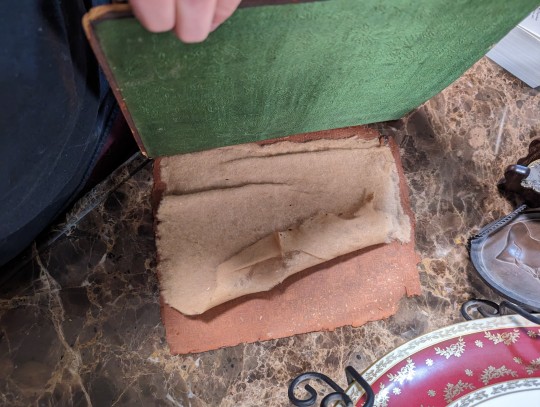
#napoleon#napoleon bonaparte#antique book#JT Herbert Baily#david belasco#i own a book from a famous guy's library!
9 notes
·
View notes
Text

David Belasco, Childs' Restaurant Scene in The Governor’s Lady - Wikimedia
"A Belasco production is nothing if not realistic in every detail... "
2 notes
·
View notes
Text
Madama Butterfly Slovene National Opera Ljubljana

View On WordPress
#B.F. Pinkerton (American Naval Lieutenant)#Cho-Cho-San (Madame Butterfly)#Cio-Cio-San#Conductor Olsi Qinami London City Philharmonic and National Radio Symphony Orchestra of Albania#David Belasco American Playwright#Deželno Gledališče Provincial Theatre#Director Vinko Möderndorfer#Director was Vinko Möderndorfer#Festival Ljubljana#German Nemško Gledališče Theatre#Giacomo Puccini Italian Composer#Glover Garden Memorial Tamaki Miura Nagasaki#Gordana Hleb Mezzo-Soprano#Goro (Marriage Broker)#Ivan Andres Arnšek Baritone#Japan Opera Singer Tamaki Miura#John Luther Long American Lawyer and Writer#Kate Pinkerton (B.F. Pinkerton’s American Wife). Ana Dežman Soprano#Ljubljana LUV Fest#Luis Chapa Tenor#Madama Butterfly Slovene National Opera Ljubljana#Madama Butterfly Visit Ljubljana#Madama Lead Role Cio-Cio-San#Madame Butterfly SNG Opera#Marko Ferjančič Bass#Matej Vovk Tenor#Play Madame Butterfly: A Tragedy of Japan#Prince Jamadori (Rich Japanese Prince)#Rebeka Lokar Soprano#Robert Brezovar Baritone
0 notes
Text
1 note
·
View note
Text

Lenore Ulric was a star of the Broadway theatre as well as Hollywood films of the silent-film and early sound era. Discovered in 1913 by theater director David Belasco, who would go on to manage her stage career.
101 notes
·
View notes
Text
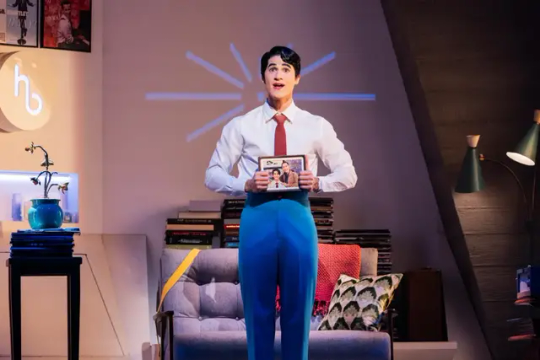
Darren Criss on Bringing Robot Love to Broadway With ‘Maybe Happy Ending’
Chances are the multi-talented Darren Criss is as cross-eyed as the rest of us are with the twists and turns his career has taken over the past 13 years. In 2009, he began in television with six years of Glee, playing the lead singer of the Warblers, and helping power a Warblers focused soundtrack album to Number 2 on the Billboard album chart. Then in 2018 he switched fromsinging to spree killing, giving a stunning, steel-plated performance as Andrew Cunanan in Ryan Murphy’s American Crime Story: The Assassination of Gianni Versace. That got him a Golden Globe and a Primetime Emmy and set people to thinking there might be a serious actor lurking inside that singer.
Before that could be settled, the singer reemerged, as a replacement in a Broadway revival of How to Succeed in Business Without Really Trying, raking in $4 million during his three weeks. That was followed with an Off-Broadway revival of Little Shop of Horrors at the Westside Theater and a stint in Hedwig and the Angry Inch at the Belasco Theater.
Two years ago, the actor was back when producer Jeffrey Richards hired him for some deep-dish David Mamet drama, American Buffalo. Now Richardshas returned Criss to the Belasco, and singing, for an original Broadway musical, Maybe Happy Ending—a very original musical, in that it’s about the love life of robots in Seoul circa 2064.
You’ll not find much of that Glee guy you know and love in the character Criss plays in Maybe Happy Ending, a lonely Helperbot robot who putters aimlessly about his tiny apartment, listens to jazz and devotes all his TLC to a favorite pot plant. That changes swiftly when a female form of Helperbot, Claire (Helen J Shen), drops by to borrow his charger. Sparks fly, then conversation, and inevitably a kind of amorous connection.
Despite the nuts and bolts, what we have here is basically a rom-com, with a charming book and score by a couple of NYU classmates.
Actually, there are two books and two scores, one in English, one in Korean. Will Aronson, 43, of New Haven, composed the music, and Hue Park, 41 of South Korea wrote the lyrics. Once they did that, they put their heads together and wrote “connecting tissue”—a play in praise of love’s rejuvenating effects. Even robots at the end of their warranty are susceptible.
Evidently, Hue won the toss because the Korean version premiered first—in Seoul, where the story is set—and proved to be such a success that stateside productions were put together. The English edition made its first U.S. appearance two years ago at Atlanta’s Alliance Theater, where The New York Times’ Jesse Green deemed it “Broadway-ready.” Thus, we now have a live-action robot show going strong on West 44th.
The terror of doing this kind of production, Criss confesses, is that actors are afraid they’ll look like cartoons of their character, taking big, blocky robot steps around the stage. “The show has no listed choreographer,” he tells Observer. But he feels he has that situation well in hand. He and director Michael Arden “have taken a particular interest in making sure the physicality is distinct,” he says. “And I’d be remiss not to mention a teacher at Juilliard, Moni Yakim, who had some Zoom discussion with us about this.
“It’s kind of a cocktail of those three things: Moni��s suggestions, Michael’s pursuit of perfection and my own interest in physical theater. It’s a skill set that I’ve never been able to utilize—at least to this level. When I was in college, I took a semester off so that I could study physical theater at the Accademia dell’Arte, the performing arts school in Arezzo, Italy.”
A cast of four inhabit the show: Dez Duron, Marcus Choi, Criss, and Shen. You may detect a little kinetic energy between Criss and Shen. That’s because they both attended the University of Michigan—albeit, not at the same time. “She graduated about two seconds ago, and I may have graduated a little longer ago than that,” concedes Criss.
“She graduated two years ago, and 10 years ago my name was up on the marquee at the Belasco Theater. And to be able to come back to the Belasco—but this time to share that billing with a fellow Michigan grad—is a very special moment for me. I’m now the upper-class man to the freshman of Helen J Shen. This is her Broadway debut. It’s a big moment for her, and getting to see her through that on stage—to call that a job is really a special thing for me.”
The enthusiasm Criss brings to the stage is practically palpable—and he still remembers where it came from: encountering Robin Williams at an impressionably early age in the 1992 animated Disney flick, Aladdin, in which his outrageous Genie-jiving was almost heart-stoppingly hilarious.
“I was probably six or seven—and I noticed how this audience connected with each other and with this Genie on the screen. I was very taken with that idea, and I wanted to give people what this Genie was giving them. Then, I found out the voice of that Genie was Robin Williams, who was such a prominent figure out in San Francisco, where I grew up. That made it an accessible concept: ’Oh, Mr. Williams is an actor. I’d like to be an actor, too.’ So I hopped right on it.”
#darren criss#observer#helen j shen#michael arden#robin williams#uofmichigan#maybe happy ending#maybe happy ending bway#press#nov 2024
29 notes
·
View notes
Text
Evelyn Preer
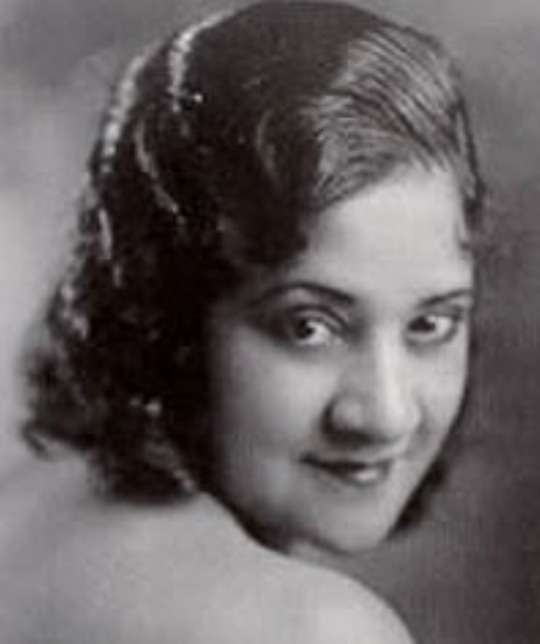
Evelyn Preer (née Jarvis; July 26, 1896 – November 17, 1932), was an African American pioneering screen and stage actress, and jazz and blues singer in Hollywood during the late-1910s through the early 1930s. Preer was known within the Black community as "The First Lady of the Screen."
She was the first Black actress to earn celebrity and popularity. She appeared in ground-breaking films and stage productions, such as the first play by a black playwright to be produced on Broadway, and the first New York–style production with a black cast in California in 1928, in a revival of a play adapted from Somerset Maugham's Rain.
Evelyn Jarvis was born in Vicksburg, Mississippi, on July 26, 1896. After her father, Frank, died prematurely, she moved with her mother, Blanche, and her three other siblings to Chicago, Illinois. She completed grammar school and high school in Chicago. Her early experiences in vaudeville and "street preaching" with her mother are what jump-started her acting career. Preer married Frank Preer on January 16, 1915, in Chicago.
At the age of 23, Preer's first film role was in Oscar Micheaux's 1919 debut film The Homesteader, in which she played Orlean. Preer was promoted by Micheaux as his leading actress with a steady tour of personal appearances and a publicity campaign, she was one of the first African American women to become a star to the black community. She also acted in Micheaux's Within Our Gates (1920), in which she plays Sylvia Landry, a teacher who needs to raise money to save her school. Still from the 1919 Oscar Micheaux film Within Our Gates.
In 1920, Preer joined The Lafayette Players a theatrical stock company in Chicago that was founded in 1915 by Anita Bush, a pioneering stage and film actress known as “The Little Mother of Black Drama". Bush and her troupe toured the US to bring legitimate theatre to black audiences at a time when theaters were racially segregated by law in the South, and often by custom in the North and the interest of vaudeville was fading. The Lafayette Players brought drama to black audiences, which caused it to flourish until its end during the Great Depression.
She continued her career by starring in 19 films. Micheaux developed many of his subsequent films to showcase Preer's versatility. These included The Brute (1920), The Gunsaulus Mystery (1921), Deceit (1923), Birthright (1924), The Devil’s Disciple (1926), The Conjure Woman (1926) and The Spider's Web (1926). Preer had her talkie debut in the race musical Georgia Rose (1930). In 1931, she performed with Sylvia Sidney in the film Ladies of the Big House. Her final film performance was as Lola, a prostitute, in Josef von Sternberg's 1932 film Blonde Venus, with Cary Grant and Marlene Dietrich. Preer was lauded by both the black and white press for her ability to continually succeed in ever more challenging roles, "...her roles ran the gamut from villain to heroine an attribute that many black actresses who worked in Hollywood cinema history did not have the privilege or luxury to enjoy." Only her film by Micheaux and three shorts survive. She was known for refusing to play roles that she believed demeaned African Americans.
By the mid-1920s, Preer began garnering attention from the white press, and she began to appear in crossover films and stage parts. In 1923, she acted in the Ethiopian Art Theatre's production of The Chip Woman's Fortune by Willis Richardson. This was the first dramatic play by an African-American playwright to be produced on Broadway, and it lasted two weeks. She met her second husband, Edward Thompson, when they were both acting with the Lafayette Players in Chicago. They married February 4, 1924, in Williamson County, Tennessee. In 1926, Preer appeared on Broadway in David Belasco’s production of Lulu Belle. Preer supported and understudied Lenore Ulric in the leading role of Edward Sheldon's drama of a Harlem prostitute. She garnered acclaim in Sadie Thompson in a West Coast revival of Somerset Maugham’s play about a fallen woman.
She rejoined the Lafayette Players for that production in their first show in Los Angeles at the Lincoln Center. Under the leadership of Robert Levy, Preer and her colleagues performed in the first New York–style play featuring black players to be produced in California. That year, she also appeared in Rain, a play adapted from Maugham's short story by the same name.
Preer also sang in cabaret and musical theater where she was occasionally backed by such diverse musicians as Duke Ellington and Red Nichols early in their careers. Preer was regarded by many as the greatest actress of her time.
Developing post-childbirth complications, Preer died of pneumonia on November 17, 1932, in Los Angeles at the age of 36. Her husband continued as a popular leading man and "heavy" in numerous race films throughout the 1930s and 1940s, and died in 1960.
Their daughter Edeve Thompson converted to Catholicism as a teenager. She later entered the Sisters of St. Francis of Oldenburg, Indiana, where she became known as Sister Francesca Thompson, O.S.F., and became an academic, teaching at both Marian University in Indiana and Fordham University in New York City.

Still from the 1919 Oscar Micheaux film Within Our Gates.
60 notes
·
View notes
Note
Is there a particular story arc featuring Magik that you consider to be your favorite?
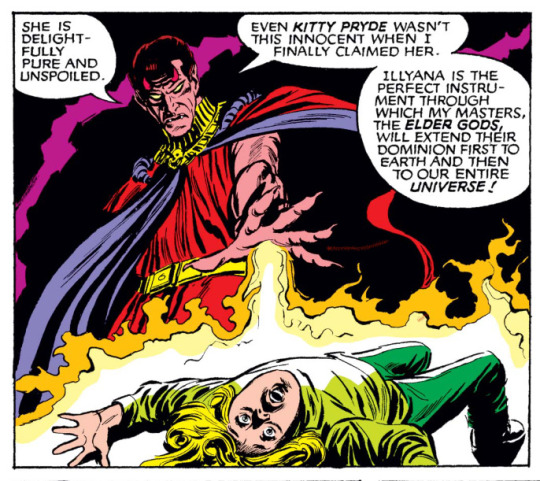
Magik #1 (1983) MARVEL
Fall of the New Mutants ranks high on my list of story arcs centered around Magik. Belasco stole Illyana from her family as a child with one goal in mind, to use her to release the Elder Gods. Magik was kidnapped, abused, and manipulated for the sole purpose of becoming the catalyst for their destruction of creation.


New Mutants #21 (2011) MARVEL
Magik deceives everyone that she loves and puts earth at risk by recruiting David Haller / Legion to use his mutant powers to negate the existence of the Elder Gods from reality. Legion obliterates the gods, and returns the stolen pieces of Illyana and Pixie’s souls to them in exchange for his freedom.


New Mutants #25 (2011) MARVEL
Illyana’s plan succeeds, but it comes with a price. For manipulating the X-Men in her personal quest for vengeance against the Elder Gods, Magik is imprisoned in a mutant detention center known as the X-Brig, located miles beneath the island headquarters of the X-Men in San Francisco.
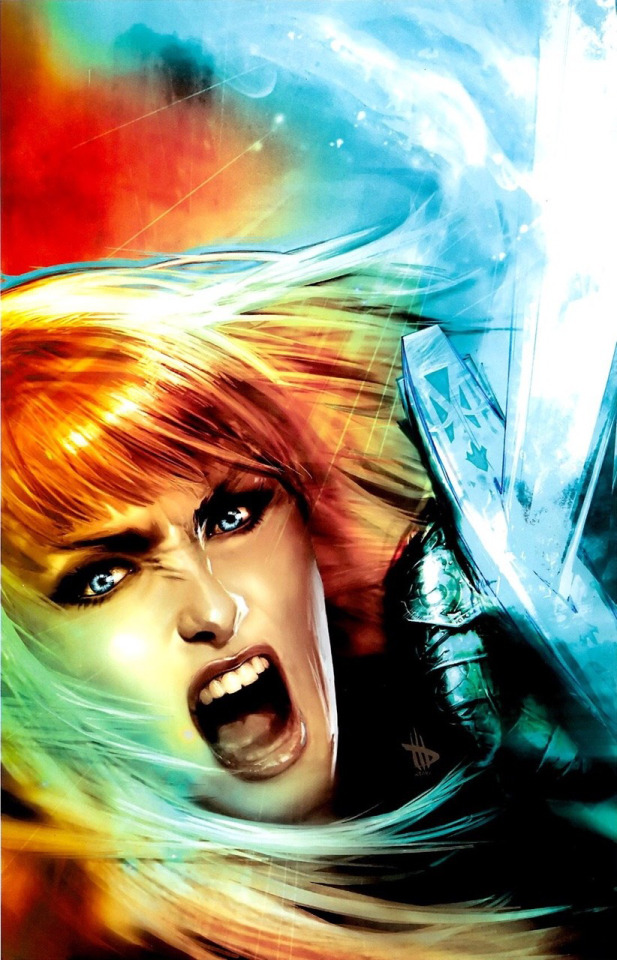
Dave Wilkins
The entirety of Illyana’s existence up to this point was dedicated to battling the demonic corruption of her soul, and preventing an apocalypse by her former mentor’s deities. For years, I wondered what would happen once five Bloodstones were created and placed into the Beatrice Medallion. This event unfolds in Fall, and it is epic. Illyana’s revenge against her captor’s ancient gods after years of build-up is satisfying, if bittersweet. Zeb Wells really crafted an iconic moment in Magik’s character biography.
#Magik#Illyana Rasputin#The New Mutants#Fall of the New Mutants#X-Men#Marvel#Marvel Comics#Comics#Comic Books#Zeb Wells
30 notes
·
View notes
Text
Darren Criss on Bringing Robot Love to Broadway With ‘Maybe Happy Ending’
The star of the new musical on learning to move like a machine and how he first caught the acting bug.
Chances are the multi-talented Darren Criss is as cross-eyed as the rest of us are with the twists and turns his career has taken over the past 13 years. In 2009, he began in television with six years of Glee, playing the lead singer of the Warblers, and helping power a Warblers focused soundtrack album to Number 2 on the Billboard album chart. Then in 2018 he switched fromsinging to spree killing, giving a stunning, steel-plated performance as Andrew Cunanan in Ryan Murphy’s American Crime Story: The Assassination of Gianni Versace. That got him a Golden Globe and a Primetime Emmy and set people to thinking there might be a serious actor lurking inside that singer.
Before that could be settled, the singer reemerged, as a replacement in a Broadway revival of How to Succeed in Business Without Really Trying, raking in $4 million during his three weeks. That was followed with an Off-Broadway revival of Little Shop of Horrors at the Westside Theater and a stint in Hedwig and the Angry Inch at the Belasco Theater.
Two years ago, the actor was back when producer Jeffrey Richards hired him for some deep-dish David Mamet drama, American Buffalo. Now Richardshas returned Criss to the Belasco, and singing, for an original Broadway musical, Maybe Happy Ending—a very original musical, in that it’s about the love life of robots in Seoul circa 2064.
You’ll not find much of that Glee guy you know and love in the character Criss plays in Maybe Happy Ending, a lonely Helperbot robot who putters aimlessly about his tiny apartment, listens to jazz and devotes all his TLC to a favorite pot plant. That changes swiftly when a female form of Helperbot, Claire (Helen J Shen), drops by to borrow his charger. Sparks fly, then conversation, and inevitably a kind of amorous connection.
Despite the nuts and bolts, what we have here is basically a rom-com, with a charming book and score by a couple of NYU classmates.
Actually, there are two books and two scores, one in English, one in Korean. Will Aronson, 43, of New Haven, composed the music, and Hue Park, 41 of South Korea wrote the lyrics. Once they did that, they put their heads together and wrote “connecting tissue”—a play in praise of love’s rejuvenating effects. Even robots at the end of their warranty are susceptible.
Evidently, Hue won the toss because the Korean version premiered first—in Seoul, where the story is set—and proved to be such a success that stateside productions were put together. The English edition made its first U.S. appearance two years ago at Atlanta’s Alliance Theater, where The New York Times’ Jesse Green deemed it “Broadway-ready.” Thus, we now have a live-action robot show going strong on West 44th.
The terror of doing this kind of production, Criss confesses, is that actors are afraid they’ll look like cartoons of their character, taking big, blocky robot steps around the stage. “The show has no listed choreographer,” he tells Observer. But he feels he has that situation well in hand. He and director Michael Arden “have taken a particular interest in making sure the physicality is distinct,” he says. “And I’d be remiss not to mention a teacher at Juilliard, Moni Yakim, who had some Zoom discussion with us about this.
“It’s kind of a cocktail of those three things: Moni’s suggestions, Michael’s pursuit of perfection and my own interest in physical theater. It’s a skill set that I’ve never been able to utilize—at least to this level. When I was in college, I took a semester off so that I could study physical theater at the Accademia dell’Arte, the performing arts school in Arezzo, Italy.”
A cast of four inhabit the show: Dez Duron, Marcus Choi, Criss, and Shen. You may detect a little kinetic energy between Criss and Shen. That’s because they both attended the University of Michigan—albeit, not at the same time. “She graduated about two seconds ago, and I may have graduated a little longer ago than that,” concedes Criss.
“She graduated two years ago, and 10 years ago my name was up on the marquee at the Belasco Theater. And to be able to come back to the Belasco—but this time to share that billing with a fellow Michigan grad—is a very special moment for me. I’m now the upper-class man to the freshman of Helen J Shen. This is her Broadway debut. It’s a big moment for her, and getting to see her through that on stage—to call that a job is really a special thing for me.”
The enthusiasm Criss brings to the stage is practically palpable—and he still remembers where it came from: encountering Robin Williams at an impressionably early age in the 1992 animated Disney flick, Aladdin, in which his outrageous Genie-jiving was almost heart-stoppingly hilarious.
“I was probably six or seven—and I noticed how this audience connected with each other and with this Genie on the screen. I was very taken with that idea, and I wanted to give people what this Genie was giving them. Then, I found out the voice of that Genie was Robin Williams, who was such a prominent figure out in San Francisco, where I grew up. That made it an accessible concept: ’Oh, Mr. Williams is an actor. I’d like to be an actor, too.’ So I hopped right on it.”
6 notes
·
View notes
Text

Propaganda
Lee Gentry (Crime Without Passion) - SAUL GOODMAN WHO?? Lee is the OG 'hot lawyer' and I love him and his stupid little mustache. The fact that I would will purposefully try to get thrown in jail for a chance he'd defend me says something about me but I don't care. ALSO THE TOP HAT AND TUXEDO COMBO? (see attached) Deceased.
David Belasco (Lady with Red Hair) - The floof should speak for itself, guys c'mon!
This is round one for The King of The Claudes tournament and other matchups can be found here!
Additional Propaganda under the cut!
Lee Gentry
THIS IS WHERE THIS STUPID GIF COMES FROM AHH!!!



David Belasco
youtube
youtube
#round one#claude rains#kingoftheclaudes#kingoftheclaudespoll#polls#tournament poll#tumblr polls#classic hollywood#old hollywood#crime without passion#crime without passion 1934#lady with red hair#lady with red hair 1940#david belasco#lee gentry
30 notes
·
View notes
Text

From left, David Belasco, Arturo Toscanini and Giacomo Puccini, during one of the composer’s two formative visits to New York City.
20 notes
·
View notes
Text
Just curious, have you guys heard of this guy?

#david belasco#american theatrical producer#not my usual interests but I'll tell you why im asking - I'm just curious if anyone knows him first
1 note
·
View note
Video
Mary Pickford by Truus, Bob & Jan too! Via Flickr: Vintage Swedish postcard. Förlag Nordisk Konst, Stockholm, No. 1236. Mary Pickford (1892-1979) was a legendary silent film actress and was known as 'America’s sweetheart.' She was a founder of United Artists and helped establish the Academy. Mary Pickford was born Gladys Mary Smith in 1892, in Toronto, Canada. She was the sister of actor/director Jack Pickford and stage/screen actress Lottie Pickford. Pickford began performing at the age of five on the stage and was known for a time as 'Baby Gladys.' After touring in different shows and productions for more than nine years, she went to New York to conquer Broadway. In 1907, she made her Broadway debut in The Warrens of Virginia. David Belasco, the producer of the play, insisted that Gladys Smith assume the stage name, Mary Pickford. In 1909, Pickford got into film, working for D. W. Griffith, a director and head of the Biograph Company (American Mutoscope & Biograph). That same year, 'the girl with the curls' appeared in 40 films for Biograph (According to some sources even 51 films). In January 1910, Griffith moved his operation to California, and Pickford went with him. Actors were not listed in the credits of the Biograph pictures. Audiences noticed and identified Pickford within weeks of her first film appearance. Exhibitors in turn capitalized on her popularity by advertising on sandwich boards that a film featuring 'The Girl with the Golden Curls' or 'The Biograph Girl' was inside. Pickford left Biograph in December 1910. The following year, she starred in films at Carl Laemmle's Independent Moving Pictures Company (IMP). Unhappy with their creative standards, Pickford returned to work with Griffith in 1912. Some of her best performances were in his films, such as Friends, The Mender of Nets, and The Female of the Species. In 1913, she moved on to Adolph Zukor who had formed one of the first American feature film companies: Famous Players in Famous Plays later known as Paramount Pictures. Hearts Adrift (1914) made her irresistible to moviegoers. The film was so popular that Pickford asked for the first of her many publicized pay raises based on the profits and reviews. The film marked the first time Pickford’s name was featured above the title on cinema marquees.Tess of the Storm Country was released five weeks later. Biographer Kevin Brownlow observed that the film "sent her career into orbit and made her the most popular actress in America, if not the world." Over the years, her fame grew as well as her salary. 'Little Mary' became an international star, beloved for her beauty and charm. She often appeared on screen in young girl roles, even when she was an adult. Some of Mary Pickford’s greatest films were a collaborative effort with her friend and writer-director Frances Marion. Together they worked on such hits as Rebecca of Sunnybrook Farm (1917) and Poor Little Rich Girl (1917). She also worked as a producer and co-founded United Artists, with D.W. Griffith, Charlie Chaplin, and Douglas Fairbanks, Sr., who would become her second husband. She had been married to actor Owen Moore since 1911 and divorced him in 1920 to be with Fairbanks. Mary Pickford and Douglas Fairbanks married in 1920, becoming one of Hollywood’s earliest supercouples. Fans adored the pairing, and the couple were known to host fabulous events at their home, called Pickfair, which were attended many of the leading figures in film. In the 1920s, Pickford continued to score more box-office hits with Polyanna (1920) and Little Lord Fauntleroy (1922). Ernst Lubitsch came to America at Mary's invitation to direct Dorothy Vernon of Haddon Hall (1924), but when he arrived he had changed his mind and would not do it (it was eventually directed by Marshall Neilan). Instead, he and Mary made Rosita (1923) together. She was one of the original 36 founders of the Academy of Motion Picture Arts and Sciences in 1927. Around this time, the film industry was changing and talking pictures were on the rise. In 1929, Pickford starred in her first talkie Coquette, which explored the dark side of a wealthy family. She won an Academy Award for her work on the film. Still she was never quite able to recreate the phenomenal success she had in the silent pictures with the sound films. Her last film was Secrets (1933). Mary Pickford retired from the screen in 1933 but continued to produce. In 1936, she divorced Douglas Fairbanks. A year later, she married her third husband, actor and bandleader Charles 'Buddy' Rogers. They stayed together until her death and adopted two children. Mary Pickford died in 1979 in Santa Monica, California. Sources: The Biography.com website, Wikipedia and IMDb.
#female#Hollywood#Silent#USA#AMerican#1920s#1910s#Sepia#Swedish#Sweden#Nordisk Konst#Vintage#Vedette#Postcard#Postkarte#POstale#Postkaart#Portrait#Cinema#Carte#Cine#Cartolina#cARD#Carte Postale#Celebrity#Costume#Film#Film Star#Movies#Movie Star
2 notes
·
View notes
Text
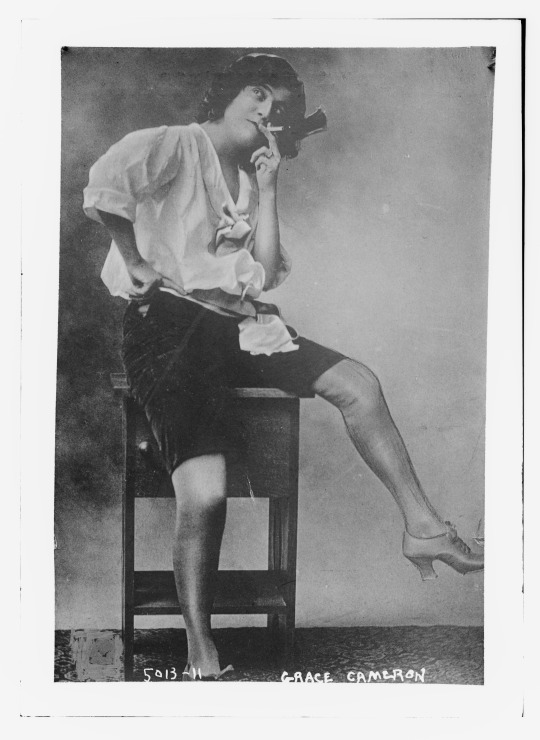
"....singer Grace Cameron, who in September, 1919 sued for an annulment of her marriage [probably why it ran in the Bain News Service.]
She was in a number of shows between 1900 and 1908.
A biographical sketch taken from the LOC page: "Grace Cameron was born on August 1, 1879 (with the name Grace Kerr) in Storm Lake, Iowa. The comic singer joined the famous touring group called The Bostonians and was in Robin Hood, playing the role of Maid Marian.
She recorded five titles issued on two-minute Edison Standard cylinders and four issued on four-minute wax Amberols. "Adam and Eve" (Amberol 136) and "Whose Baby Girl Are You?" (Standard 10265) had been introduced by Cameron in the 1908 show The Pied Piper.
She was probably a mezzo-soprano though Edison literature identified her only as "comedienne."
Her single Columbia disc featured "Since Dolly Dimples Made A Hit" backed by "I'll Bet I'd Be A Riot Down On Broadway" (A1205), recorded on July 11, 1912. "Since Dolly Dimples Made A Hit," with lyrics by William Jerome and music by Jean Schwartz, is from the 1904 musical Piff! Paff! Pouf!, which was produced by F.C. Whitney for the Casino Theater in New York and starred Eddie Foy, with Cameron cast as one of his daughters. In telling of Dolly, the song alludes to many topical events and stage personalities--Lillian Russell, David Belasco, Charlie Frohman, Leslie Carter, Duse. Dolly is a mere chorus-girl in a musical comedy, but because its author gave Dolly a few lines to speak, she behaves as though she is the show's star:
Dolly Dimples in the chorus She had served her time. She joined it when Kirlafy Brothers They were in their prime. She carried a spear For many a year. Contented in the back row With her eighteen per a week Until the night the author Handed her a line to speak And little Dolly Dimples made a hit. Since Dolly Dimples made a hit There's been an awful change. Her mother really wouldn't know her now. She gives the other girls the icy bow...
In the June 1970 issue of Hobbies, Jim Walsh reports that she was the first theatrical performer to pay, in 1905, for advertising in Variety. The date of her death is unknown. Walsh states in the August 1973 issue of Hobbies that Cameron was said to be living in Long Beach, California, in retirement in the early 1960s."
Library of Congress. LC-B2- 5013-11. hdl.loc.gov/loc.pnp/ggbain.29342
2 notes
·
View notes